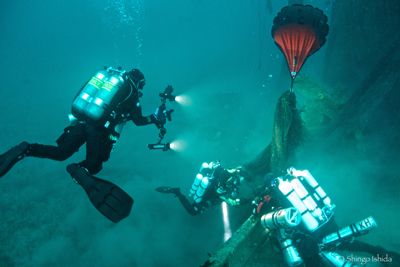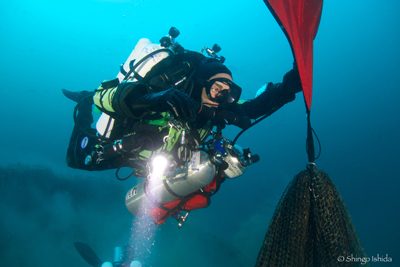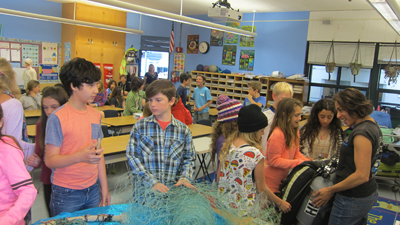
Ghost Fishing: A Global Problem
 There are certain images of marine life that consistently conjure up a predicted response from the general public, whether they are scuba divers or not. Consider the bloody waters resulting from the dolphin slaughter at Taiji, Japan.
There are certain images of marine life that consistently conjure up a predicted response from the general public, whether they are scuba divers or not. Consider the bloody waters resulting from the dolphin slaughter at Taiji, Japan.
Picture a massive whale, having just breached, with a high-powered harpoon impaled in his or her body. Imagine hundreds of dead sharks lined up with their dorsal fins sliced off. These stories and images typically elicit anger, rage, devastation, sadness, and/or feelings of powerlessness.
Now, what if I told you that there are additional human-induced atrocities against these creatures, happening all over the world, every single day? These every-day events not only affect marine mammals and elasmobranchs (sharks, rays), but also turtles, sea birds, fish, crustaceans, and benthic (bottom-dwelling) marine life.
These common, daily occurrences are a direct result of the commercial fishing industry, and actually pose a greater threat to our oceans than the aforementioned “sensationalized” activities.
As a side note, many people justify their seafood consumption by saying that they catch it themselves. Interestingly, the combined efforts of “anglers” is just as devastating as commercial fishermen; warranting an entire chapter on recreational fishing in “The Empty Ocean” by Richard Ellis.
Commercial fishing, whether it is gill netting; trawling; purse seining; or long-lining- inevitably results in varying degrees of “non-target” catches, or “by-catch” amounting to anywhere from 60-90% of the total catch. Every year there are easily billions of these unintended catches, considered to be of no commercial value, causing incalculable and very likely irreparable damage to fragile aquatic ecosystems.
The other devastating secondary effect of commercial fishing is the issue of ghost nets- which will be the focus of this article.
 THE PROBLEM
THE PROBLEM
“Ghost fishing“ is a term used to describe what occurs with abandoned or lost commercial fishing gear that inevitably continues to fish.
Across the scientific literature, ghost fishing is universally recognized as detrimental to the environment and the fish stocks. When commercial fishing gear is lost or abandoned, it will continue to fish for months, years, perhaps even indefinitely. This is due to the sturdy, non-biodegradable materials that fishing nets (and pots) are typically made of.
Over the last few years, our dedicated volunteers in Southern California from Los Angeles Underwater Explorers (LAUE) have been responsible for cleaning up thousands of pounds of ghost nets, and rescuing innumerable lives.
THE SOLUTION
“Ghost Fishing” was founded in the Netherlands by Pascal van Erp and Cas Renooij, two Global Underwater Explorers (GUE) technical divers. They dive mostly in the North Sea, spending a lot of time cleaning up ghost nets. Ghost Fishing now has projects in 14 countries, using mostly GUE trained divers.
I have the honor of being the US Coordinator. Unfortunately there is no shortage of work for us to do, with several target sites right here in the Los Angeles area. The majority of our work is in technical depths.
A ghost net removal project begins with a reconnaissance dive. We must ascertain depth; type of net; condition of the net; and draw a basic sketch of the structure along with video and/or photos. All of this information will be used in the dive briefing for the actual cleanup. (Please note that this work is incredibly dangerous and I do not endorse engaging in these dives without the proper training and credentials!)
Recovered nets are now being recycled- a very exciting development in our work!
Fourth Element is making swimsuits and rash guards: www.oceanpositive.net
Bureo is making skateboard decks: http://www.bureoskateboards.com
CAN WE PREVENT THIS?
Establishing a connection with policymakers is critical so that the mandatory early reporting of lost gear can be established; which has already been implemented in Washington State and has been largely successful.
Our own personal experience has shown us that the sooner we can get to these ghost nets, the easier they are to clean up. Additionally, the sooner we can get to these nets, the less time they have to keep trapping and killing marine life.
 While “top down” tactics are more likely to be effective at generating change, a “bottom up” approach should not be overlooked. This includes education and promoting awareness in school-age children. We have already had children come on the boat with us, and they love the work that we are doing.
While “top down” tactics are more likely to be effective at generating change, a “bottom up” approach should not be overlooked. This includes education and promoting awareness in school-age children. We have already had children come on the boat with us, and they love the work that we are doing.
They genuinely enjoy participating, such as helping to manage the nets and rescuing trapped creatures. Our presentations at schools for children of all ages, and dive club meetings have also been well received. The children are enamored with our scuba gear and the other “show and tell” items that we provide (lift bags, piles of nets, underwater videos, etc.).
The problem of ghost fishing stems from the incessant demand for seafood. One way to counter this is to eat a plant-based diet.
There are actually no nutrients in seafood that one cannot obtain from plant-based foods. (As a vegan since 1/1/2009, I practice what I preach!)
www.ghostfishing.org
www.facebook.com/ghostfishing
Written by Heather Hamza , California